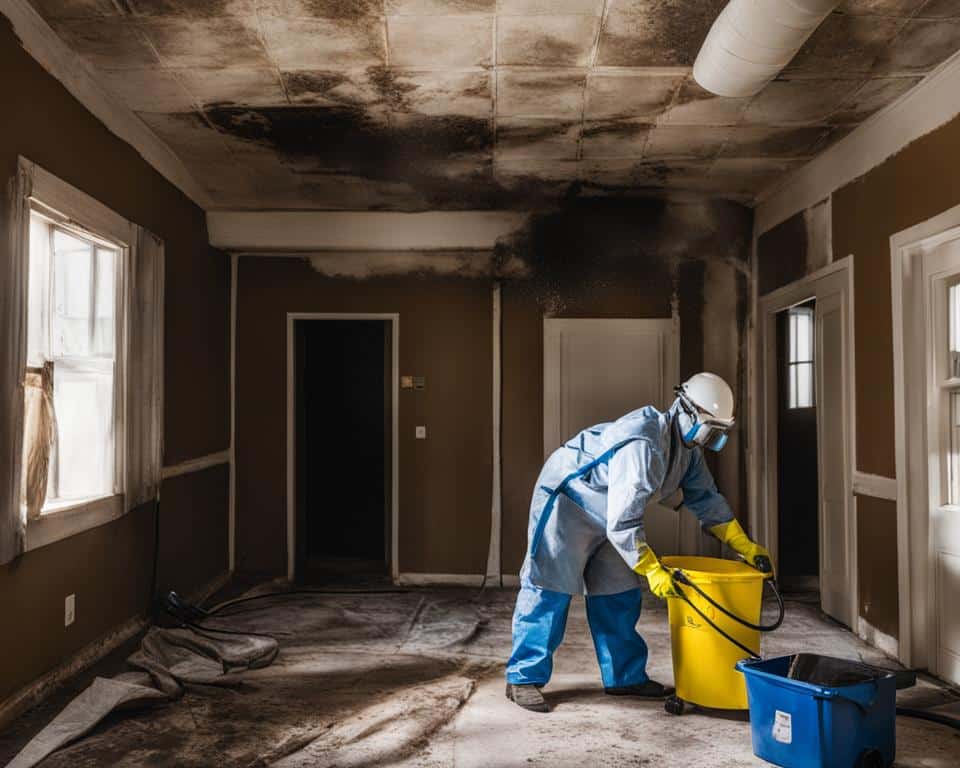If you suspect that your home has a mold problem and are considering remediation, you may wonder whether it is safe to remain in the house during the process. While it may be tempting to stay put and monitor the remediation progress, doing so can pose risks to your health and compromise the effectiveness of the remediation process.
During mold remediation, mold spores can become airborne and spread throughout the house, potentially causing respiratory issues, allergies, and other adverse reactions. To protect your health and the integrity of your home, it is essential to take the necessary precautions and engage professional mold remediation services.
Key Takeaways:
- Staying in a house during mold remediation can pose health risks and compromise the effectiveness of the remediation process.
- Mold spores can become airborne and spread throughout the house during remediation.
- Professional mold remediation services have the expertise and equipment necessary for thorough mold removal.
- Precautions such as proper ventilation and personal protective equipment should be taken during remediation.
- Air quality monitoring and post-remediation verification are essential for ensuring the safety of your home.
Understanding the Risks of Mold Exposure
When it comes to mold remediation, the potential health risks of mold exposure cannot be overstated. Mold spores can cause a range of adverse reactions, from minor irritations to more severe respiratory issues. Individuals with pre-existing conditions such as asthma and allergies are particularly susceptible to the effects of mold exposure.
Mold spores are tiny particles that float in the air and can easily spread throughout a house. When mold grows in damp environments, such as bathrooms, basements, or attics, it releases spores into the air. These spores can then settle on surfaces and grow into new colonies if not properly addressed. Simply put, the longer mold is allowed to thrive in a house, the more it can spread, exacerbating any health risks.
It’s important to note that not all types of mold are dangerous, and some may not cause any adverse health reactions. However, it’s difficult to determine the type of mold present without a professional inspection and testing. Therefore, it is crucial to take mold remediation seriously and follow the necessary precautions to protect your health and home.
Next, we will discuss the importance of hiring a professional mold remediation company to handle the process.
The Importance of Professional Mold Remediation
If you have discovered mold in your home, it is crucial to act quickly and engage the services of a certified mold remediation company. While it may be tempting to attempt a DIY approach, it is important to understand that effective mold removal requires specialized expertise and equipment.
A professional mold remediation company will have the necessary training and experience to identify the extent of the mold problem, determine the cause of the infestation, and develop an effective remediation plan. By working with a professional, you can ensure that the mold is removed safely and effectively, and that the underlying issue is addressed to prevent future mold growth.
In addition to the expertise and equipment necessary for effective remediation, a professional mold remediation company will also follow industry best practices and guidelines to ensure the safety of your home and its occupants. This includes taking precautions such as containing the affected areas, using proper ventilation, and wearing personal protective equipment.
| Key Benefits of Professional Mold Remediation |
|---|
| Effective mold removal |
| Prevention of future mold growth |
| Increased safety for home and occupants |
| Compliance with industry standards and guidelines |
By engaging the services of a certified mold remediation company, you can have peace of mind knowing that your mold problem is being handled safely and effectively. Don’t put your health and home at risk – trust the experts to handle the remediation process.
Precautions to Take During Mold Remediation
When dealing with mold remediation, safety should be your top priority. Protect yourself, your family, and your home by taking the necessary precautions. Here are some of the safety measures and protective equipment you should consider:
| Precautionary Measure | Explanation |
|---|---|
| Ventilation | Ensure proper ventilation in the affected areas by opening windows, using fans, and turning on air conditioning or dehumidifiers to reduce moisture levels. |
| Personal Protective Equipment (PPE) | Wear PPE, such as gloves, goggles, and respirators, to protect yourself from mold exposure and other hazardous materials during the remediation process. |
| Containment | Contain the affected areas to prevent mold spores from spreading throughout the house. This may involve sealing off doors and windows, covering floors and furniture, and using negative air pressure machines. |
| Cleaning | Clean and disinfect surfaces that have been affected by mold to prevent further contamination. Use a solution of bleach and water (1 cup of bleach per gallon of water) to clean surfaces. |
| Temporary Relocation | If the mold infestation is severe or the remediation process poses significant risks, consider temporarily relocating until the remediation is complete. |
By taking these precautions, you can reduce the risk of health problems and ensure that the remediation process is effective in removing the mold problem. Remember to consult a certified mold remediation company for professional assistance and guidance.
Monitoring Air Quality and Clearances
After the mold remediation process is complete, it is crucial to ensure that the air in your home is safe to breathe. This is where air quality monitoring and clearance testing come into play. These processes provide objective data on the effectiveness of the remediation efforts and whether the mold problem has been completely eliminated.
Air quality monitoring involves testing the air in your home for mold spores and other contaminants. This is typically done by taking air samples from various locations in your home and analyzing them in a laboratory. The results will indicate the level of mold spores in the air and whether they are within safe limits.
Clearance testing, also known as post-remediation verification, is the final step in the mold remediation process. This involves a thorough inspection and testing of the entire mold-infested area to ensure that the mold has been completely removed. Clearance testing is typically done by a certified mold inspector or industrial hygienist who will thoroughly inspect the area for any remaining signs of mold. They will also take samples and send them to a laboratory for analysis to confirm that the mold has been fully removed.
| Benefits of Air Quality Monitoring and Clearance Testing |
|---|
| Provides objective data on the effectiveness of the remediation efforts |
| Ensures that the air in your home is safe to breathe |
| Confirms that the mold problem has been completely eliminated |
| Provides peace of mind for you and your family |
By conducting air quality monitoring and clearance testing, you can be confident that your home is safe and free from mold. If the results indicate that there are still mold spores present, further remediation may be necessary. However, if the remediation efforts were successful, you can move forward with the knowledge that your home is now a healthy and safe living environment for you and your family.
Conclusion
In conclusion, it’s not safe to stay in a house during mold remediation as it can pose risks to your health and compromise the effectiveness of the remediation process. To ensure your safety, it’s crucial to prioritize your well-being and the long-term integrity of your home by engaging professional mold remediation services and following the necessary precautions.
It’s essential to understand the risks of mold exposure, the importance of hiring a certified mold remediation company, and taking precautions during mold remediation. Additionally, monitoring air quality and clearance testing are necessary to ensure that the air in your home is safe to breathe and that the remediation efforts have been successful in removing the mold problem.
By taking these steps, you can manage your health and home with confidence, knowing that you have mitigated the risks associated with mold exposure. Remember that your health and safety are paramount, and do not attempt a DIY approach to mold remediation, as it may be insufficient in ensuring thorough remediation. Hire a professional mold remediation company and take all the necessary precautions to ensure a safe and effective remediation process.
FAQ
Is it safe to stay in a house during mold remediation?
It is generally not recommended to stay in a house during mold remediation. Mold exposure can pose health risks, and the remediation process may involve the use of chemicals or the disturbance of mold spores, which can increase the risk of exposure. It is best to consult with a professional mold remediation company to assess the situation and determine the appropriate course of action.
What are the risks of mold exposure?
Mold exposure can lead to various health issues, including respiratory problems, allergies, asthma attacks, and other adverse reactions. Mold spores can also spread throughout the house and contaminate other areas. It is important to address mold growth promptly to minimize the risk of health complications.
Why is it important to hire a professional mold remediation company?
Professional mold remediation companies have the expertise, equipment, and experience necessary to effectively remove mold and prevent its recurrence. They can ensure thorough remediation and take proper precautions to protect your health and home. Attempting to handle mold remediation on your own may not be sufficient in addressing the problem completely.
What precautions should be taken during mold remediation?
During mold remediation, it is important to ensure proper ventilation to minimize the spread of mold spores. Personal protective equipment, such as gloves, masks, and goggles, should be worn to prevent exposure. If the extent of the mold infestation or the remediation process poses significant risks, temporary relocation may be necessary to ensure safety.
Why is monitoring air quality and obtaining clearances important?
Monitoring air quality and obtaining clearances through post-remediation verification ensure that the air in your home is safe to breathe and that the mold problem has been effectively addressed. These processes provide reassurance that the remediation efforts have been successful in removing the mold and ensuring a healthy living environment.






